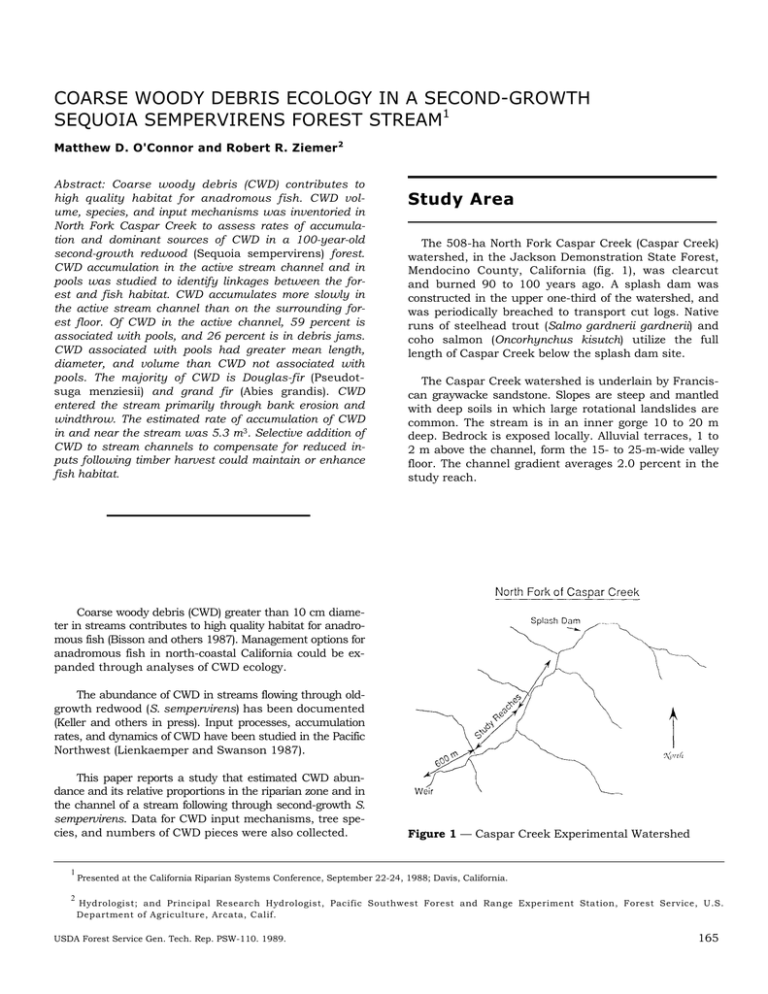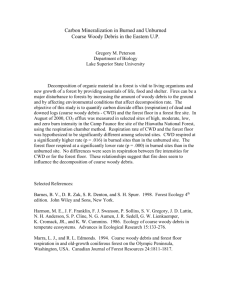COARSE WOODY DEBRIS ECOLOGY IN A SECOND-GROWTH SEQUOIA SEMPERVIRENS FOREST STREAM
advertisement

COARSE WOODY DEBRIS ECOLOGY IN A SECOND-GROWTH SEQUOIA SEMPERVIRENS FOREST STREAM1 Matthew D. O'Connor and Robert R. Ziemer2 Abstract: Coarse woody debris (CWD) contributes to high quality habitat for anadromous fish. CWD volume, species, and input mechanisms was inventoried in North Fork Caspar Creek to assess rates of accumulation and dominant sources of CWD in a 100-year-old second-growth redwood (Sequoia sempervirens) forest. CWD accumulation in the active stream channel and in pools was studied to identify linkages between the forest and fish habitat. CWD accumulates more slowly in the active stream channel than on the surrounding forest floor. Of CWD in the active channel, 59 percent is associated with pools, and 26 percent is in debris jams. CWD associated with pools had greater mean length, diameter, and volume than CWD not associated with pools. The majority of CWD is Douglas-fir (Pseudotsuga menziesii) and grand fir (Abies grandis). CWD entered the stream primarily through bank erosion and windthrow. The estimated rate of accumulation of CWD in and near the stream was 5.3 m3. Selective addition of CWD to stream channels to compensate for reduced inputs following timber harvest could maintain or enhance fish habitat. Study Area The 508-ha North Fork Caspar Creek (Caspar Creek) watershed, in the Jackson Demonstration State Forest, Mendocino County, California (fig. 1), was clearcut and burned 90 to 100 years ago. A splash dam was constructed in the upper one-third of the watershed, and was periodically breached to transport cut logs. Native runs of steelhead trout (Salmo gardnerii gardnerii) and coho salmon (Oncorhynchus kisutch) utilize the full length of Caspar Creek below the splash dam site. The Caspar Creek watershed is underlain by Franciscan graywacke sandstone. Slopes are steep and mantled with deep soils in which large rotational landslides are common. The stream is in an inner gorge 10 to 20 m deep. Bedrock is exposed locally. Alluvial terraces, 1 to 2 m above the channel, form the 15- to 25-m-wide valley floor. The channel gradient averages 2.0 percent in the study reach. Coarse woody debris (CWD) greater than 10 cm diameter in streams contributes to high quality habitat for anadromous fish (Bisson and others 1987). Management options for anadromous fish in north-coastal California could be expanded through analyses of CWD ecology. The abundance of CWD in streams flowing through oldgrowth redwood (S. sempervirens) has been documented (Keller and others in press). Input processes, accumulation rates, and dynamics of CWD have been studied in the Pacific Northwest (Lienkaemper and Swanson 1987). This paper reports a study that estimated CWD abundance and its relative proportions in the riparian zone and in the channel of a stream following through second-growth S. sempervirens. Data for CWD input mechanisms, tree species, and numbers of CWD pieces were also collected. Figure 1 — Caspar Creek Experimental Watershed 1 Presented at the California Riparian Systems Conference, September 22-24, 1988; Davis, California. 2 Hydrologist; and Principal Research Hydrologist, Pacific Southwest Forest and Range Experiment Station, Forest Service, U.S. Department of Agriculture, Arcata, Calif. USDA Forest Service Gen. Tech. Rep. PSW-110. 1989. 165 At the lower end of the study reach, the mean annual flood occurs between November and May at about 0.5 m flow depth, with a discharge of about 3.1 m3 flow depth of 1 m (discharge 8.5 m3/sec) would be expected once every 25 years at this location in the watershed. During late summer, the minimum streamflow averages about 0.001 m3/s. CWD volume was calculated as for a cylinder. Ratio estimators (Cochran 1977) were used to estimate total CWD volume in each zone. Methods CWD Volume The volume of CWD was estimated in three zones defined as follows: Classification Description Effective zone Within the active channel, up to 0.5 m above the water surface or the channel bed. Potential zone Suspended 0.5 m or more above the channel, extending laterally 1 m beyond the vertical channel bank. Valley floor Stream channel and terraces; lateral boundary is steep slope These classifications are hierarchical. The effective zone lies below, is smaller than, and exclusive of the potential zone; the valley floor includes both the effective and potential zones (fig. 2). Our definitions of effective and potential CWD are similar to those used by Swanson and others (1984) and partition CWD into present and future supplies. Functionally, effective zone CWD was that in contact with the water column during the mean annual flood. Potential zone CWD was that transferable to the effective zone by breakage or bank erosion. CWD volume in the potential and effective zones was estimated by measuring lengths and end diameters of CWD pieces with a stadia rod and log calipers in random sample plots. The 1850-m study reach was divided into 185 plots 10 m long and three 600-m sub-reaches (figs. 1 and 2a). To ensure even distribution of sampling, 20 plots were selected from each sub-reach. Portions of CWD pieces outside the plot were ignored. Plot size varied with channel width; the area within each plot was estimated as the product of length (10 m) and the mean of 3 active channel width measurements. 166 Figure 2 – Plan and cross-section views of sampling zones in Caspar Creek, California. (a) Plan View: Relationship of geomorphic features to sample plot and linetransect. Lateral plot boundary parallels streambank at a distance of 1 m. (b) Effective zone width determined by active channel. Effective zone contained in potential zone; potential zone contained in valley floor. USDA Forest Service Gen. Tech. Rep. PSW-110. 1989. The line transect technique (Van Wagner 1968) was used to estimate quantities of CWD on the valley floor. Random transects extended 50 m diagonally across the valley floor in a "zig-zag" pattern (fig. 2a,b). CWD volume per unit area of valley floor was estimated as: V = ((π )2 /8L * ∑ (d) 2 where L was the transect length (50 m) and d was diameter of CWD in meters. Base-flow fish habitat was inventoried by Decker and Lisle (work ongoing, unpublished data for June 1987) using the habitat classification scheme of Bisson and others (1982) modified for use in northern California. Pools were classified according to the cause of formation, e.g., scour around a rootwad, deflection by bedrock outcrop. CWD that affected inventoried pools ("associated" became a subset of effective zone CWD. CWD that created a scour zone that aided pool formation, or was in a pool, or appeared to be in the water column above a pool during the average annual flood was classified as "pool-associated." CWD in the effective zone was also classified according to whether it was part of a woody debris jam, defined as aggregations of at least three CWD pieces. Whether CWD pieces appeared to have been mobilized by streamflows was also noted. railroad ties. Wind fragmentation included pieces broken from a snag. Landslide CWD was defined as tree falls with rootwads in landslide deposits. The unknown category was used when no input mechanism could be identified. Results CWD Volume and Density We estimate that 1180 m3 of CWD lies on the valley floor in the 1850-m study reach (table 1), 37 percent (437 m3) of which is in either the potential zone (25 percent) or the effective zone (12 percent). Seven percent of CWD in the study area was pool-associated. Table 1- Coarse woody debris volume and density at Caspar Creek, California. Valley Floor Potential + Effective Potential Effective Pool-Associated Total +S.E. (m3) 1180 ± 182 437 ± 41 294 ± 34 143 ± 16 84 ± 14 Area (ha) 3.03 1.29 1.29 0.82 Density (m3/ha) 389 339 228 174 Debris Jams Effective Pool-Associated 57 ± 20 38 ± 8 CWD Species Tree species from which CWD originated was recorded. Because of the difficulty of distinguishing Abies grandis from Pseudotsuga menziesii, these were lumped together as "fir." S. sempervirens was the only other species found in substantial quantity. A third category of "other" species included known species with minor representation and CWD for which the species could not be determined. CWD Sources Six sources of CWD were identified: (1) bank erosion, (2) windthrow, (3) logging debris, (4) wind fragmentation, (5) landslide, or (6) unknown. Bank erosion included rootwads or trees with attached rootwads which collapsed from the banks into the channel. Windthrow was defined as tree falls with attached rootwads originating from the valley floor and adjacent slopes. (Tree falls attributed to bank erosion, simply because of the trees' proximity to the stream, might have been caused by wind.) Logging debris included pieces with cut ends, burn scars, or milled edges, such as bridge parts and USDA Forest Service Gen. Tech. Rep. PSW-110. 1989. CWD accumulates in the combined potential and effective zones at the same rate that it accumulates on the valley floor. CWD density on the valley floor was 389 m3/ha, and in the combined potential and effective zones, 339 m3/ha (table 1). The 95 percent confidence interval of the difference includes 0 (50 + 133 m3/ha). CWD accumulates in the effective zone at a slower rate than on the valley floor. CWD density in the effective zone was 174 m3/ha. The 95 percent confidence interval of the difference in density between the effective zone and the valley floor did not include 0 (215 + 124 m3/ha). In the effective zone, 59 percent of the CWD volume was pool-associated. CWD Species Differences in species composition were statistically significant (95 percent confidence level) for the combined data from the potential and effective zones, where fir was more abundant than redwood, and redwood was more abundant than other CWD. Despite limited statistical evidence, we are confident that fir-derived CWD is 167 about two times more abundant than redwood—both volume and number of pieces—and that other species are insignificant for practical purposes (fig. 3). We attribute the lack of statistical evidence to the estimators used, the high frequency of null data in sample plots, and the inability to identify species of rotted pieces. Figure 3 - Coarse woody debris species as percentage of sample volume (a) and pieces (b) at Caspar Creek, California. Figure 4 - Coarse woody debris as a percentage of sample volume (a) and pieces (b) at Caspar Creek, California. 168 USDA Forest Service Gen. Tech. Rep. PSW-110. 1989. CWD Sources The high proportion of CWD volume and number of pieces classified as "unknown" (fig. 4) were due to the long time since some of the trees fell, and the tendency of fallen trees to be fragmented and transported by the stream. Because of this tendency, differences between sources were not statistically significant. m3/ha to 4500 m3/ha. The CWD density we measured in Caspar Creek is comparable to that for P. menziesii old-growth forest streams in the Klamath Mountains– mean of 282 m3/ha and range from 10 m3/ha to 1200 m3/ha for 11 sample reaches (Harmon and others 1986). CWD Ecology Despite these classification problems, most CWD volume in the potential zone (60 percent) was windthrown fir. Many fallen trees uprooted from the lower slopes of the inner gorge criss-crossed the valley floor and were suspended above the stream channel. The high percentage of CWD from logging found on the valley floor (36 percent of volume), came from a few large diameter redwood pieces. Only 8 percent of the pieces on the valley floor were logging remnants. In the effective zone and its pool-associated component, windthrow and logging contributed approximately equal proportions of CWD. Bank erosion contributed about as many pieces of CWD as windthrow and logging combined. Debris jams, which develop after CWD input, are of equal or greater importance than direct input processes (windthrow and bank erosion) as pool-associated debris. Debris jams accounted for 27 percent of the volume and 56 percent of the pieces of pool-associated CWD. Diameter and length affected the likelihood of CWD being associated with pools and being transported by the stream. Mean length, mean diameter, and mean volume of CWD was significantly greater, at the 95 percent level of confidence, when associated with pools than when it was not. The mean volume of CWD associated with pools was 0.17 m3 compared with 0.07 m3 for CWD not associated with pools. Mobile CWD had significantly smaller mean values of length, diameter, and volume than non-mobile CWD. The mean volume of mobile CWD was 0.06 m3, compared with 0.16 m3 for non-mobile CWD. Discussion And Conclusions CWD Density The mean density of CWD in Caspar Creek, 339 m3/ha (combined potential and effective zones), is less than that for many streams in old-growth redwood forest. Mean CWD for 12 sample reaches in Redwood National Park were reported by Keller and others (in press) to be 1590 m3/ha. The densities ranged from 240 USDA Forest Service Gen. Tech. Rep. PSW-110. 1989. The distribution of CWD can be visualized as follows: of each 10 m3 of CWD within the limits of the valley floor, about 2.5 m3 are in the potential zone, 1.2 m3 are in the effective zone, and 6.3 m3 are lying on that portion of the valley floor outside of these two zones. Within the effective zone, 0.7 m3 of CWD are associated with pools. We attribute this distribution in large part to the dimensions of the stream channel and the mechanics of tree fall. Because the channel lies within vertical streambanks 1 to 2 m high, many trees fall across the channel and remain suspended above it. Trees falling from greater horizontal distances are less likely to be suspended above the channel because their upper trunks shatter or are not supported by the opposite bank. Tree trunks broken into lengths less than or equal to the width of the channel (4 to 5 m) are more likely to enter the effective zone. Trees falling parallel to the channel have a better chance of entering the effective zone because they do not have support points on both banks. Trees succumbing to bank erosion are likely to enter the effective zone. CWD entering the effective zone tends to become pool-associated in these situations: when the piece is massive and is situated such that a pool is formed by scour, if the piece becomes lodged in a debris jam which in turn causes bed-scour and pool formation, or if the piece happens to fall directly into an existing pool. Circumstances in which CWD is associated with pools are limited due to the precise placement required to form pools. The predominance of CWD from A. grandis and P. menziesii reflects successional dynamics of the redwood forest ecosystem. Windthrow, disease, and competition have thinned these species from this 100-year-old secondgrowth forest. The "climax" species, S. sempervirens, is less common as CWD and is particularly uncommon as windthrow. The dominant CWD sources (input mechanisms) are windthrow and bank erosion. Windthrow is the dominant source for the potential zone, much of which originates from adjacent slopes. This is consistent with data for Oregon streams, where 90 percent of CWD originated within 30 m of the stream (McDade 1987). Bank erosion is the most common source of effective zone CWD. Logging debris, mostly in the form of redwood rootwads, is a valuable and stable structural element of the channel, but is a limited resource at Caspar Creek. 169 Debris jams are major components of the pool-associated class of CWD. Debris jams associated with pools typically are located at channel constrictions, sharp bends, or obstructions (e.g., redwood stumps, boulders). Much CWD in debris jams is small enough to be floated during floods. habitat, indicating that mobile (smaller) CWD is also beneficial. Acknowledgments CWD in the effective zone–which is likely to contribute to fish habitat–originates from both far and near the channel and from both the old-growth forest and its successor. Both stable and mobile pieces are associated with pools, which are thought to be the most valuable habitat. Considering the complexity of CWD ecology, one basis for managing CWD is maintaining or increasing the abundance of CWD and the diversity of sources, sizes, and positions. J. A. Baldwin generously provided statistical assistance. L. M. Decker provided fish habitat data for Caspar Creek from an on-going study. Staffs of the Jackson Demonstration State Forest, and California Department of Forestry and Fire Protection provided invaluable assistance and loaned facilities, vehicles, and equipment. R. L. Beschta, M. D. Bryant, and F. J. Swanson provided excellent reviews of the manuscript. Rate of CWD Accumulation References Logging techniques at the turn of the century left little debris in the stream channel at Caspar Creek. Subtracting logging debris from CWD volume, and dividing by 60 years (the first 30 years of regrowth is assumed to have contributed little CWD), yields estimates of annual accumulation rates as follows: Potential & Effective Combined Potential Effective Pool-Associated 5.3 3.5 2.7 1.6 m3/ha/yr m3/ha/yr m3/ha/yr m3/ha/yr For a 100 m reach 5 m wide, the addition each year of one log 4 m long and 0.3 m in diameter would be equivalent to the accumulation rate for the potential and effective zones combined. These estimates could guide efforts to deliberately add CWD to similar streams that are deficient in fish habitat. Professional judgement would be required to determine the appropriate methods and locations needing additional CWD. During logging, unmerchantable logs might be deliberately placed in desired locations. Such additions could be distributed among potential and effective zones to provide an even supply of CWD to the stream over time. Alternatively, if streamside bufferstrips do not preserve an adequate natural source area for CWD, deliberate additions of CWD to the stream might be made in proportion to the expected contribution lost from the source area over the duration of the cutting cycle (e.g., 50 years). Silvicultural methods could also be developed to optimize the supply of natural CWD (Rainville and others 1985). Bilby (1984) and Swanson and others (1984) suggested that massive CWD is more stable and better suited to provide desired fish habitat. We found, however, that CWD in debris jams often contributed to pool 170 Bilby, R.E. 1984. Removal of woody debris may affect stream channel stability. Journal of Forestry 82(10): 609-613. Bisson, P.E.; Bilby, R.E.; Bryant, M.D.; and others. 1987. Large woody debris in forested streams in the Pacific Northwest: past, present, and future. In: Salo, E.O.; Cundy, T.W. eds. Streamside management: forestry and fishery interactions. Contribution No. 57. Seattle: College of Forest Resources, University of Washington: 143-190. Bisson, P.E.; Nielsen, J.L.; Palmason, R.A.; Grove, L.E. 1982. A system of naming habitat types in small streams, with examples of habitat utilization by salmonids during low streamflow. In: Armantrout, N.B., ed. Acquisition and utilization of aquatic habitat inventory information. Portland, OR: Western Division, American Fisheries Society: 62-73. Cochran, W.G. 1977. Sampling techniques. 3d ed. New York: John Wiley & Sons; 413 p. Harmon, M.E.; Franklin, J.F.; Swanson, F.J.; and others. 1986. Ecology of coarse woody debris in temperate ecosystems. Advances in Ecological Research 15: 133-302. Keller, E.A.; MacDonald, A.; Tally, T.; Merritt, N.J. Effects of large organic debris on channel morphology and sediment storage in selected tributaries of Redwood Creek. In: Geomorphic processes and aquatic habitat in the Redwood Creek drainage basin. Prof. Paper. Washington, D.C.: Geological Survey, U.S. Department of the Interior. [In press]. Lienkaemper, G.W.; Swanson F.J. 1987. Dynamics of large woody debris in streams in old-growth Douglas-fir forests. Canadian Journal of Forest Resources 17: 150-156. McDade, M.H. 1987. The source area for coarse woody debris in small streams in western Oregon and Washington. Corvallis: Oregon State Univ. M.S. thesis; 1-69. USDA Forest Service Gen. Tech. Rep. PSW-110. 1989. Rainville, R.P.; Rainville, S.C.; Lider, E.L. 1985. Riparian silvicultural strategies for fish habitat emphasis. In: Proceedings of the 1985 Society of American Foresters National Convention; July 28-31; Ft. Collins, CO. Bethesda, MD: Society of American Foresters; 186-196. of Wales Island, southeast Alaska. General Technical Report PNW-166. Portland, OR: Pacific Northwest Forest and Range Experiment Station, Forest Service, U.S. Department of Agriculture; 1-12. Swanson, F.J.; Bryant, M.D.; Lienkaemper, G.W.; Sedell, J.R. 1984. Organic debris in small streams, Prince Van Wagner, C.E. 1968. The line intersect method in forest fuel sampling. Forest Science 14: 20-26. USDA Forest Service Gen. Tech. Rep. PSW-110. 1989. 171





